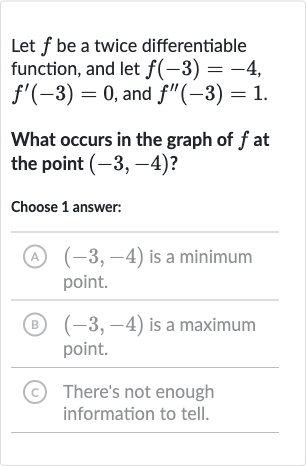Full solution
Q. Let be a twice differentiable function, and let , , and .What occurs in the graph of at the point ?Choose answer:(A) is a minimum point.(B) is a maximum point.(C) There's not enough information to tell.
- Given Information: Given that is a twice differentiable function, we have information about the function and its first two derivatives at the point . We know that , , and .
- Point on Graph: The value tells us that the point lies on the graph of the function . However, this information alone does not tell us about the nature of the point on the graph.
- Tangent Line: The derivative indicates that the slope of the tangent to the graph of at is zero. This means that the graph of has a horizontal tangent line at the point . This could be indicative of a local maximum, a local minimum, or a point of inflection.
- Concavity Analysis: The second derivative tells us about the concavity of the graph at . Since is positive, the graph of is concave up at this point. This suggests that the point is a local minimum.
- Conclusion: Combining the information from the first and second derivatives, we can conclude that the point is a local minimum on the graph of because the first derivative is zero (indicating a horizontal tangent) and the second derivative is positive (indicating concave up).
More problems from Nth roots
QuestionGet tutor help
QuestionGet tutor help
QuestionGet tutor help
QuestionGet tutor help
QuestionGet tutor help
QuestionGet tutor help

